November 23, 2025 | 15:08 GMT +7
November 23, 2025 | 15:08 GMT +7
Hotline: 0913.378.918
November 23, 2025 | 15:08 GMT +7
Hotline: 0913.378.918
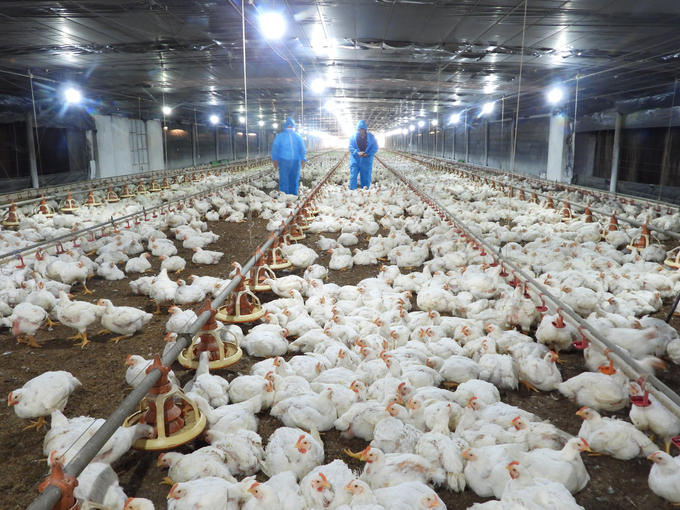
Inside the white feathered chicken farm of Do Manh Tuong in Dong No commune, Hon Quang district. Photo: Tran Trung.
Visiting Do Manh Tuong's commercial white feathered chicken farm in Dong No commune, Hon Quan district (Binh Phuoc), we were simply impressed. The spacious and clean cages were fully equipped with temperature sensor systems, electric lights, ventilation fans, automatic feeders, surveillance cameras, etc. The modern chicken raising model helps farmers like Tuong easily and effectively operate production in the industrial 4.0 era.
Taking us to visit the chicks that have just been admitted to the farm, Tuong said, “Having the farm like today is proof of a process of constant efforts, step by step accumulating experience from reality”.
In his early days, Tuong’s combined husbandry model consisted of chickens and pigs on a small scale. But due to the impact of the market economy on all fronts and complicated, unpredictable developments of the epidemic on livestock and poultry, the livestock industry took a heavy hit. Tuong himself was no exception. There were times when he thought he could not survive in the business.
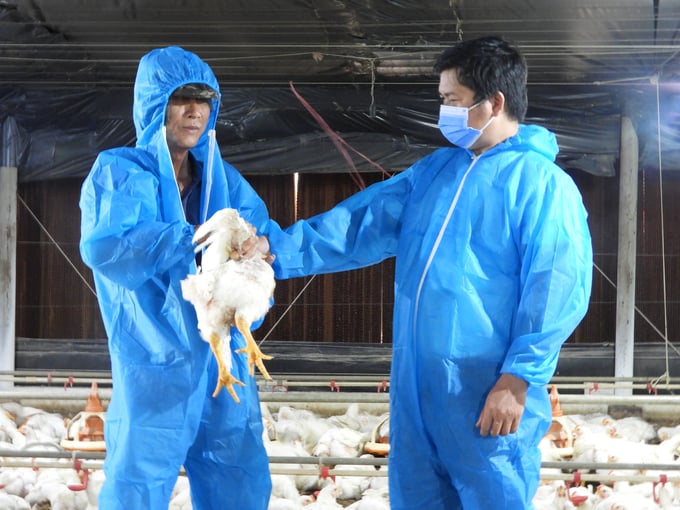
White feathered chickens have the advantage of being super meaty, fast growing, and consuming less food than traditional colored chickens. Photo: Le Binh.
With determination and passion, he spent a lot of time looking for effective economic development directions. After learning about a model of a joint venture to raise white feathered chickens following high standards in localities, Tuong quickly realized this was a form of cooperation that secured sustainable livestock development. So in 2015 he boldly took a bank loan and built his chicken farm using the closed cold cage method.
At the beginning of the association, Tuong was still very confused about the model. Thanks to "hands-on" instruction from the business, he has mastered the process and gradually expanded the production scale. From the original inefficient farm, Tuong now owns 8 farms, raising 100,000 white feathered chickens.
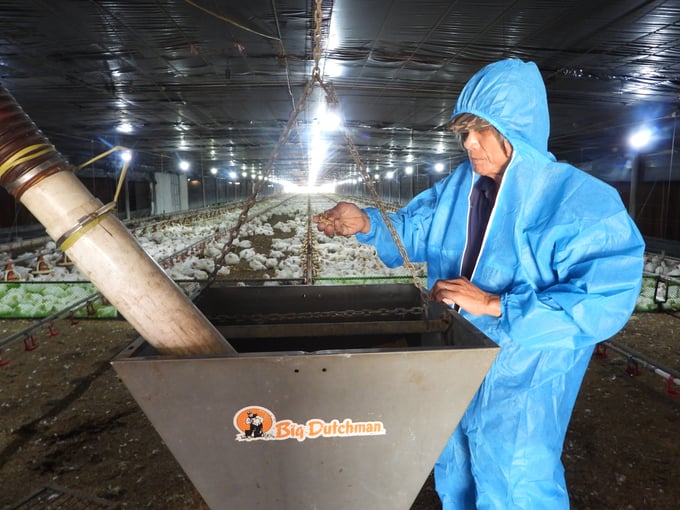
The farm produces following a closed process, using advanced equipment to apply automation, ensuring disease safety. Photo: Tran Trung.
“Farming under the association model, my white chicken farm is underwritten by De Heus company from breeding stock to release. Breeds and animal feed are provided by the company, and when released, the company buys them. Every week, the company sends staff to check the growth of the chickens and give guidance on the care techniques. Farmers only need to have a production area, capital and a lot of effort.
“There is another advantage. Because of its solid construction, the use time of cold chicken cages can be up to 10-15 years, while open chicken farms degrade after 2-3 years. Raising chickens in cold cages also greatly reduces the risk of disease thanks to good hygiene, guaranteed feed sources, thus minimizing environmental pollution," Tuong said.
According to Binh Phuoc Department of Livestock Production and Animal Health, the husbandry sector in the province has developed in the direction of commodity production. Breeding methods have shifted sharply from small-scale and self-sufficient to farm-scale.
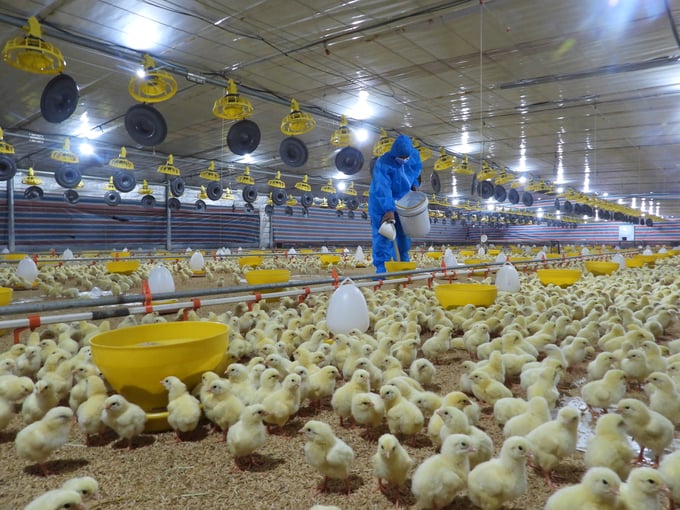
Binh Phuoc’s husbandry sector has gradually developed in the direction of commodity production. Photo: Le Binh.
Currently, Binh Phuoc has about 10 million poultry. If it was from 2015 or earlier, most of the livestock production facilities followed the traditional method, relying on experience instead of complying with a methodical technical process. The economic benefits of husbandry at that time were not high.
Now farm owners and livestock households have actively participated in training courses, applied technical processes and complied with disease prevention and treatment in livestock herds. There are nearly 100 farms in the entire province, of which, over 59 farms are equipped with cold, closed, automatic or semi-automatic technology. Poultry farms are mainly for outsourcing or companies and groups to hire for livestock production (such as CP, De Heus, Emivest, Japfa, etc).
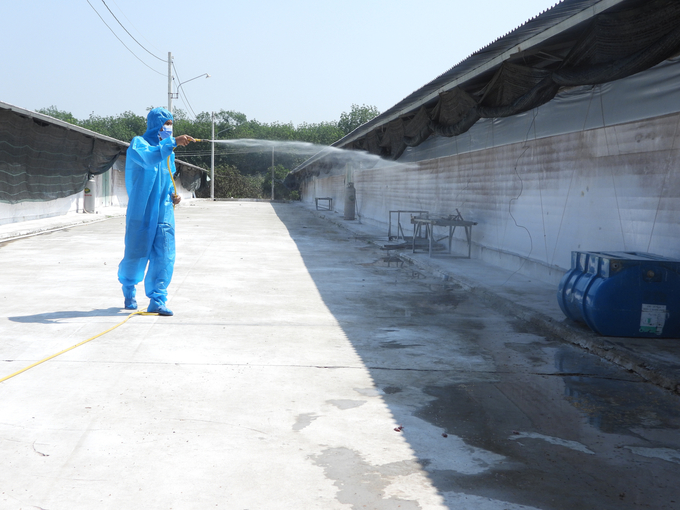
Binh Phuoc has been promoting the development of biosafety livestock for export. Photo: Tran Trung.
Tran Van Phuong, Deputy Director of Binh Phuoc Department of Agriculture and Rural Development said, “The orientation of the local poultry development in the near future is towards sustainability, disease safety, environmental safety and food hygiene. The province also aims to promote chain linkage, improve processing to increase product value and make sure that the products are qualified for export”.
Translated by Samuel Pham

(VAN) Ca Mau’s development of OCOP products opens a path to increasing cooperatives value, helping boost income, expand markets, and affirm collective economy's role.

(VAN) Turning seemingly ordinary coconut shells into unique jewelry and artwork, Nguyen Bang Nhi spreads the value of local culture through her brand, Cocohand.

(VAN) Results from the Sustainable Durian Model Project in Dak Lak have confirmed the critical role of Yara Viet Nam in transferring advanced nutritional solutions to farmers.

(VAN) In Tuyen Quang province, livestock farmers have introduced effective models and innovative practices that significantly strengthen African Swine Fever prevention and control efforts.

(VAN) This is the study conducted by IRRI and Can Tho University on the rice straw value chain in Mekong Delta showing an economic potential of more than 6.6 trillion VND/year.

(VAN) By participating in cooperative economics, many farmers in Tay Ninh have overcome hardship, mastered clean dragon fruit cultivation techniques.

(VAN) The crossbreeding program in the former Binh Dinh province (now part of Gia Lai) has shown signs of decline, and urgent measures are needed to revive it and sustain past achievements.